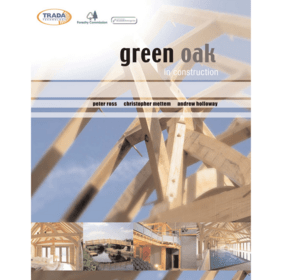Contenu
Sommaire
Chapter 1 Introduction 7
Chapter 2 Green oak past and present 10
2.1 The medieval period 10
2.2 The post-medieval period 12
2.3 The present day 13
Chapter 3 The supply of green oak 16
3.1 Timber supply 16
3.2 Environmental issues 17
3.3 Costs 20
Chapter 4 The properties of oak 22
4.1 The living oak tree 22
4.2 Timber properties 23
4.3 Moisture content and drying movement 24
4.4 Durability 29
4.5 Strength properties 31
4.6 Creep deflection 33
4.7 Working qualities 33
4.8 Chemical properties 33
4.9 Behaviour in fire 34
Chapter 5 Design of green oak structures 35
5.1 The design of the frame 35
5.2 Performance of the structure 39
5.3 Historical forms as models for today 43
5.4 Drying movements 54
Chapter 6 The green oak framing process 56
6.1 The traditional approach 56
6.2 Automation 58
6.3 Selecting the timber 59
6.4 Appearance considerations 69
Chapter 7 Enclosing green oak structures 74
7.1 Design criteria and construction forms 74
7.2 Construction detailing 74
7.3 Drying movements and maintenance 77
7.4 Example details 77
Chapter 8 Exterior uses of green oak 90
8.1 General approach to durability in design 90
8.2 Appearance grading 95
8.3 External cladding 95
8.4 Decking 96
8.5 Bridges and other external structures 98
Chapter 9 Case Studies 102
Historic reconstructions: 104
9.1 The Globe Theatre 104
9.2 Stirling Castle Roof 108
Traditional models: 112
9.3 Mill O’Braco house 112
9.4 Abingdon School Boathouse 114
Modern frames: 118
9.5 New roof to the South Transept of York Minster 118
9.6 Bedales School, Olivier Theatre 122
9.7 Darwin College, Cambridge 124
Innovative frames: 129
9.8 Weald and Downland Museum Gridshell 129
Exterior uses 133
9.9 The National Maritime Museum, Falmouth 133
9.10 Ealing Bridge 136
9.11 Polesden Lacey Bridge 139
Appendix I Specifying oak for traditional framing 141
AI.1 Defects 141
AI.2 Specification 143
Appendix II Green oak strength grading rules 148
AII.1 Scope 148
AII.2 The grades 148
AII.3 Definitions 149
AII.4 Measurement of features 150
AII.5 Grade limits 155
AII.6 Reference documentation 159
Appendix III Engineering design data 160
AIII.1 Strength design to BS 5268-2: 2002 160
AIII.2 Strength design to Eurocode 5 Part 1.1 161
AIII.3 Deflection of beams 161
AIII.4 Self weight of frames 163
AIII.5 Strength of pegged joints in tension 163
Appendix IV The green oak strength grading rules: Quick referencesheet 164
References and further reading 166
Glossary of terms 172
Chapter 2 Green oak past and present 10
2.1 The medieval period 10
2.2 The post-medieval period 12
2.3 The present day 13
Chapter 3 The supply of green oak 16
3.1 Timber supply 16
3.2 Environmental issues 17
3.3 Costs 20
Chapter 4 The properties of oak 22
4.1 The living oak tree 22
4.2 Timber properties 23
4.3 Moisture content and drying movement 24
4.4 Durability 29
4.5 Strength properties 31
4.6 Creep deflection 33
4.7 Working qualities 33
4.8 Chemical properties 33
4.9 Behaviour in fire 34
Chapter 5 Design of green oak structures 35
5.1 The design of the frame 35
5.2 Performance of the structure 39
5.3 Historical forms as models for today 43
5.4 Drying movements 54
Chapter 6 The green oak framing process 56
6.1 The traditional approach 56
6.2 Automation 58
6.3 Selecting the timber 59
6.4 Appearance considerations 69
Chapter 7 Enclosing green oak structures 74
7.1 Design criteria and construction forms 74
7.2 Construction detailing 74
7.3 Drying movements and maintenance 77
7.4 Example details 77
Chapter 8 Exterior uses of green oak 90
8.1 General approach to durability in design 90
8.2 Appearance grading 95
8.3 External cladding 95
8.4 Decking 96
8.5 Bridges and other external structures 98
Chapter 9 Case Studies 102
Historic reconstructions: 104
9.1 The Globe Theatre 104
9.2 Stirling Castle Roof 108
Traditional models: 112
9.3 Mill O’Braco house 112
9.4 Abingdon School Boathouse 114
Modern frames: 118
9.5 New roof to the South Transept of York Minster 118
9.6 Bedales School, Olivier Theatre 122
9.7 Darwin College, Cambridge 124
Innovative frames: 129
9.8 Weald and Downland Museum Gridshell 129
Exterior uses 133
9.9 The National Maritime Museum, Falmouth 133
9.10 Ealing Bridge 136
9.11 Polesden Lacey Bridge 139
Appendix I Specifying oak for traditional framing 141
AI.1 Defects 141
AI.2 Specification 143
Appendix II Green oak strength grading rules 148
AII.1 Scope 148
AII.2 The grades 148
AII.3 Definitions 149
AII.4 Measurement of features 150
AII.5 Grade limits 155
AII.6 Reference documentation 159
Appendix III Engineering design data 160
AIII.1 Strength design to BS 5268-2: 2002 160
AIII.2 Strength design to Eurocode 5 Part 1.1 161
AIII.3 Deflection of beams 161
AIII.4 Self weight of frames 163
AIII.5 Strength of pegged joints in tension 163
Appendix IV The green oak strength grading rules: Quick referencesheet 164
References and further reading 166
Glossary of terms 172
Détails
Cette fiche est complétée et contrôlée collaborativement par la communauté. Si vous détectez des erreurs ou des manques, apportez vos propositions !
Critiques
Ce livre ne possède pour l'instant aucune critique de lecteur.
Soyez le premier à ajouter la votre !
Soyez le premier à ajouter la votre !
Connectez-vous pour ajouter votre critique.
Vous n'êtes pas autorisé à indiquer votre accord ou désaccord vos propres contributions.
L'adresse e-mail associée à votre compte doit être confirmée avant de pouvoir indiquer votre accord ou désaccord.
Chargement...
Chargement...
Publications associées
0
collection



Discussions